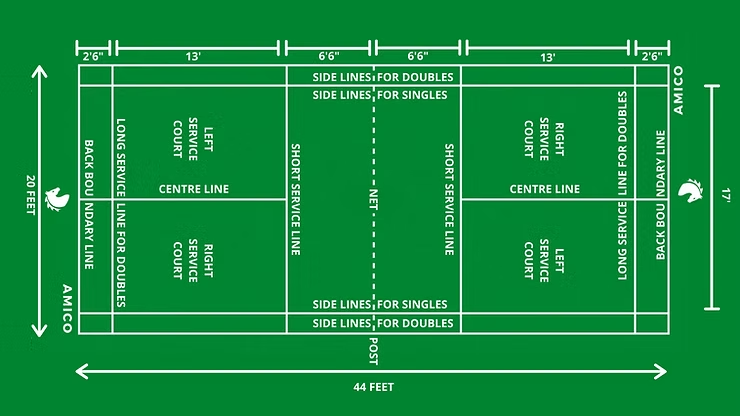A Guide to Badminton Court Dimensions and Rules
Badminton is a sport of lightning-fast reflexes, precision, and power. A flick of the wrist can send the shuttlecock screaming over the net at over 200 mph. But to master the game, you first need to understand the court and its rules, which change depending on whether you’re playing singles or doubles.
This guide will serve you the essential details on badminton court dimensions and the rules for both formats.

The Badminton Court: A Space of Precision
Unlike some sports, the badminton court has multiple lines that serve different purposes for singles and doubles play. Knowing which lines are “in” and “out” is crucial.
Court Dimensions
The total dimensions of the court remain the same, but the active play area changes.
-
Full Court Width: 6.1 meters (20 feet). This is used for doubles.
-
Singles Width: 5.18 meters (17 feet). This is marked by the inner sidelines.
-
Full Court Length: 13.4 meters (44 feet).
-
Net Height: The net is stretched across the middle of the court, with its top edge at a height of 1.55 meters (5 feet 1 inch) at the posts and 1.524 meters (5 feet) in the center.
-
Service Boxes: The area where a serve must land, defined by the center line, short service line, and the appropriate side and back lines.
Game Rules: Singles vs. Doubles
The objective is always to hit the shuttlecock over the net so that your opponent cannot return it legally. A rally is won if the shuttlecock lands inside the opponent’s court boundaries or if the opponent commits a fault.
Key Rules for All Formats
-
Scoring: All modern badminton uses a rally-point system. You get a point whenever you win a rally, regardless of who served. Games are played to 21 points. A match is the best of three games.
-
Winning a Game: You must win by at least two points. If the score reaches 20-20, play continues until one side gains a two-point lead. If the score reaches 29-29, the next point wins the game (at 30).
-
Serving: The serve must be hit underhand, with the entire shuttlecock below the server’s waist at the moment of impact. The server’s feet must be stationary inside their service court.
Specific Rules for Singles
-
Court Boundaries: The court is “long and narrow.” The playing area is defined by the inner sidelines and the very back baseline.
-
Serving: The server stands in their right service court when their score is even and their left service court when their score is odd. The serve must land diagonally in the opponent’s service court.
Specific Rules for Doubles
-
Court Boundaries: The court is “short and wide” for serving, but “long and wide” during a rally.
-
On the serve: The serve must land inside the wider side boundaries but before the long service line (the first of the two back lines).
-
During a rally: After the serve is returned, the entire court (wide sidelines and the very back baseline) is in play.
-
-
Serving Rotation: Teams have a dedicated serving rotation, ensuring partners take turns to serve. Unlike singles, the service position is determined by the serving team’s score.
Whether you prefer the one-on-one athletic challenge of singles or the strategic teamwork of doubles, understanding these lines and rules is your first step to dominating the court.
